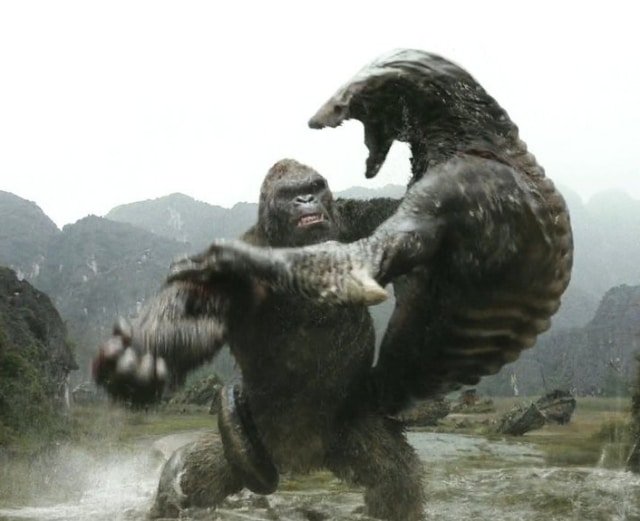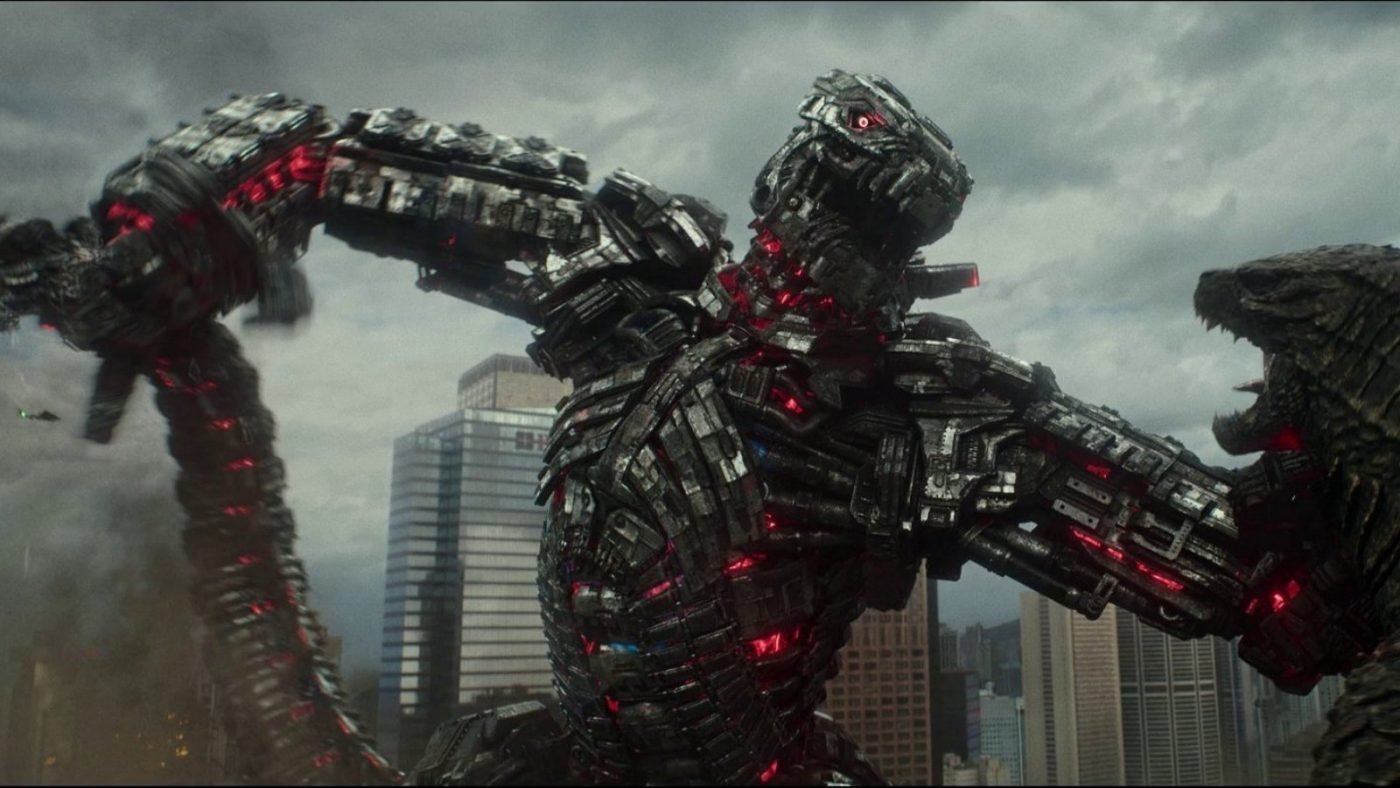Be sure to check out the whole RanKing of the Monsters Series to see who comes out on top!
Kaiju Culture Clash
The first three RanKing of the Monsters articles focused only on monsters from Japanese films, and while that will be the norm for this series, we’re making an exception this week. Fresh off hiatus, we’ll be highlighting five monsters from Legendary Pictures’ “Monsterverse,” which encompasses Godzilla (2014), Kong: Skull Island, Godzilla: King of the Monsters, and Godzilla vs. Kong.
Godzilla (Monsterverse)
First Appearance: Godzilla (2014)
Notable abilities: Atomic breath
As the first non-Japanese Godzilla design since the, um, “different” title monster that appeared in Roland Emmerich’s Godzilla (1998), Legendary Pictures’ take on the iconic kaiju needed to make its cinematic presence felt. The initial reveal of the design drew some fanboy ire – especially in Japan. The top complaints were that Godzilla was either too “fat” or too “handsome” (…) depending on whether the critics focused on his chonky build or his eagle-inspired brow.
The complaints meant little by the time Godzilla made his grand reemergence. Godzilla (2014) director Gareth Edwards builds up the full reveal for over an hour of screen time – another hotly-debated decision, but one that I think adds to Godzilla’s grandeur. Godzilla is only on screen for around 12 minutes (which is actually around the average for the entire series, contrary to what whiny naysayers claim), but Edwards makes the most of it.
Chonky Chomps
Godzilla shows up for a bit longer in 2019’s Godzilla: King of the Monsters and has some amazingly fun battles against his archnemesis, King Ghidorah. His design is largely unchanged in 2021’s Godzilla vs. Kong, but he is much more aggressive toward humans and the well-meaning Kong. He’s actually a bit of a bully in that film, but I’d be lying if I said I didn’t enjoy seeing “jerk-ass” Godzilla in a more modern context.
Whether stomping through a city or fighting another monster, this version of Godzilla makes his presence felt. Despite being entirely digital, there is plenty of weight and impact behind every action Godzilla takes. The Monsterverse version of Godzilla works equally well as a heroic monster or misunderstood villain, and I really hope he shows up for at least one more movie.
Rating: 5 out of 5
MUTO
First Appearance: Godzilla (2014)
Notable Ability: Electromagnetic pulse

The MUTO (Massive Unidentified Terrestrial Organism) is an insect-like species of kaiju that act as Godzilla’s nemeses in 2014’s Godzilla. I’m cheating a bit by combining the male and female MUTO into one entry for this ranking, but they act as a cohesive unit throughout the movie. They’re not the most memorable kaiju, but it’s great fun to watch them battle Godzilla in tandem.
The rivalry between the MUTO and Godzilla species goes back millions of years. The MUTOs feed off of radioactive material (including titans such as Godzilla) and also require a radioactive base to incubate their eggs (again, including *shudders* titans such as Godzilla). Fortunately, the modern day Godzilla wants his own radioactive feast, making him the more aggressive predator in the equation.
The MUTOs’ designs are somewhat uninspired and derivative of other movie monsters, such as the arachnids from Starship Troopers. Despite the unremarkable design, the MUTOs serve as effective antagonists in Godzilla and are even sympathetic at times. Their ability to emit electromagnetic pulses makes them a danger to humanity and they attack Godzilla mercilessly to ensure their species’ survival. At their core, however, they’re simple creatures that only care about their mate and offspring.
Rating: 3.5 out of 5
Kong (Monsterverse)
First appearance: Kong: Skull Island (2017)
Notable ability: Opposable thumbs

The version of (King) Kong that appears in Legendary Pictures’ Monsterverse is one of the more difficult kaiju to rank. Do you compare him to the 1933 version and its western-made sequels and reboots? The short answer is no. While there are occasional nods to the classic King Kong films in 2017’s Kong: Skull Island, he’s clearly more inspired by the 1962 Japanese kaiju version of the monster. In short, he's more of a professional wrestler than a symbol of mankind's exploitation of nature.
The Monsterverse version of Kong is a little less of a showman than his Toho predecessor, but is still more likely to dismember a giant octopus than ogle a screaming blonde. Watching Kong tear a bloodthirsty monster apart limb by limb is preferable to watching him smash humans, but he reluctantly takes on a misguided military squad in his Skull Island debut.
Hail to the King
Kong is more outwardly heroic than Godzilla. While he accepts being worshipped by the native inhabitants of his island, he’s mostly concerned with exterminating the more troublesome island beasties. Even while in forced captivity after the events of Skull Island, Kong acts as protector to a young girl who he communicates with via basic sign language. Kong is also, by far, the most expressive kaiju in Toho's stable, with emotional reactions that evoke empathy from the audience.
What the younger version of Kong featured in Skull Island lacks in size relative to other kaiju, he makes up for with ingenuity. His opposable thumbs allow him to create weaponry on the fly to better take on his toothier, uh… “clawier” foes, making him something like a kaiju version of The Incredible Hulk. Fully grown Kong is no less agile and is fun to watch “parkour” his way around skyscrapers with the greatest of ease. Kong isn’t the coolest-looking kaiju by a longshot, but he’s one of the most entertaining to watch fight!
Rating: 4.5 out of 5
MechaGodzilla (Monsterverse)
First Appearance: Godzilla vs Kong (2021)
Notable Abilities: Jet propulsion

Enough time has passed since Godzilla vs Kong's release to openly talk about the film's big bad, MechaGodzilla. RotM #3 featured Kiryu, the heroic, human-piloted version of MechaGodzilla from the Millennium era, setting a pretty high bar for future rankings. Neary 50 years after the mechanical doppelganger was first introduced, the Monsterverse finally brings it back to its villainous roots. While GvK's marketing centered around the fight between the title monsters, the climactic action sequence pits them both against MechaGodzilla.
Let's get the bad stuff out of the way first. The design has less personality than any previous incarnation of MechaGodzilla. You wouldn't be faulted for thinking a still image of the creature was from one of Michael Bay's Transformers movies – a comparison that brings me absolutely no joy to make. That being said, this might be the most powerful version of MechaGodzilla to date. After becoming sentient and ditching its human “pilot,” MechaGodzilla promptly, and quite literally, wipes the floor with Godzilla, who is full of confidence after his TKO of Kong.
The finale of GvK is one of the best climactic fight sequences in any kaiju film. MechaGodzilla makes up for his somewhat bland appearance with a bevy of abilities that rock the Hong Kong setting. Between its jet propulsion-powered punches, missile barrages, and spinning drill tail, MechaGodzilla nearly succeeds in taking down both title monsters. If it weren't for Kong's atomic-powered axe, the outcome would have been pretty dire for the duo of protagonists, but they (barely) manage to dismantle the metallic monstrosity. I can handle a boring-looking kaiju if it's used to such entertaining effect!
Rating: 4/5
Do you agree with my rankings? Let me know in the comments or on Twitter!

